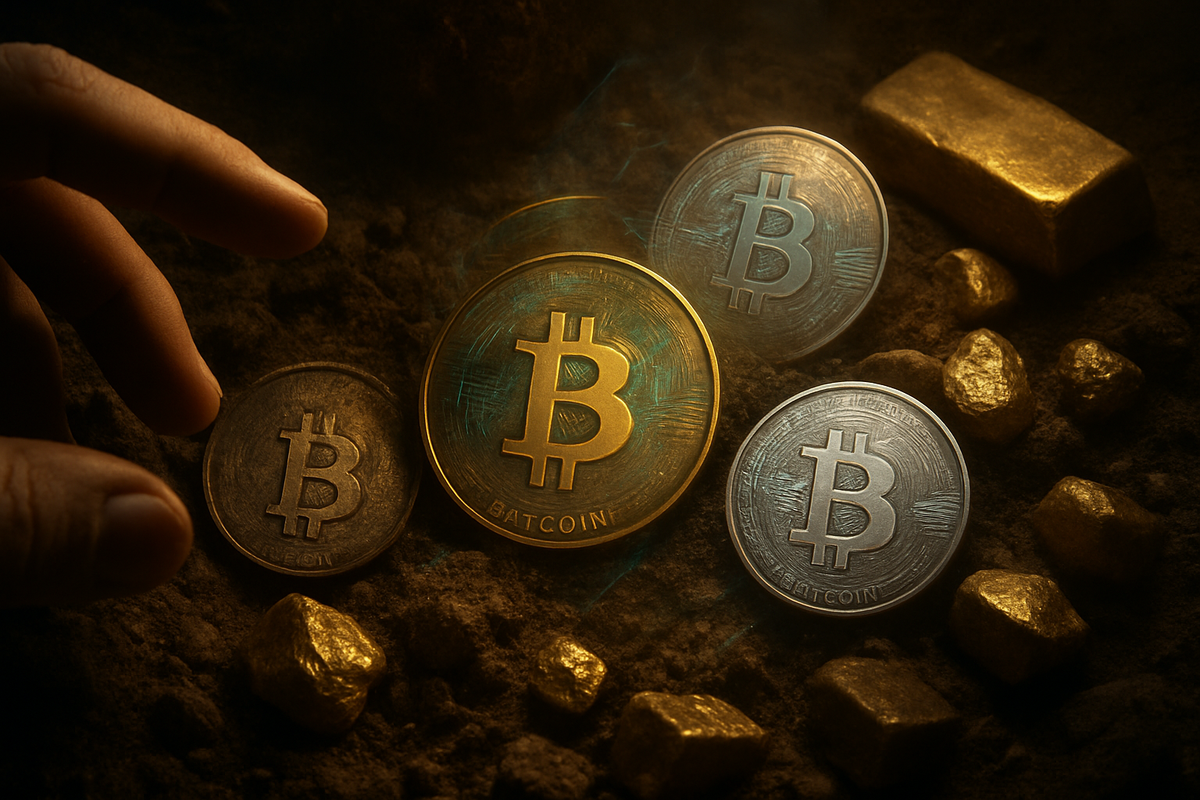
In a fascinating intersection of numismatics, precious metals, and cutting-edge cryptocurrency, a significant cache of over 38,000 Bitcoins (BTC), valued at more than $4 billion as of October 19, 2025, lies dormant within physical Casascius coins. These unique artifacts, crafted from brass, silver, and gold, represent a tangible link to Bitcoin's nascent years, offering a rare blend of digital wealth and physical artistry. The existence of these unclaimed fortunes sparks intrigue among both seasoned crypto enthusiasts and traditional precious metals investors, highlighting a peculiar chapter in financial history where digital scarcity met physical form.
The ongoing mystery of these unredeemed physical bitcoins not only underscores the early experimental spirit of the cryptocurrency movement but also presents a compelling narrative about forgotten wealth. Each Casascius coin or bar contains a private key, securely hidden beneath a tamper-evident hologram, which grants access to the digital BTC stored on the blockchain. The fact that thousands of these remain "unpeeled" means their digital contents have yet to be claimed, creating a tantalizing prospect for those who might hold them, unknowingly or otherwise. This situation raises questions about ownership, historical preservation, and the evolving nature of value in the 21st century.
A Tangible Legacy: The Story of Casascius Physical Bitcoins
The concept of a "physical bitcoin" was brought to life by Mike Caldwell, a software engineer operating under the alias "Casascius," who began minting these distinctive coins in 2011. Caldwell's vision was to create a tangible representation of Bitcoin, making the abstract digital currency more approachable and understandable in its early days. These physical bitcoins were designed to facilitate face-to-face transactions, allowing individuals to exchange BTC value as easily as they might hand over a dollar bill, albeit with a crucial digital component.
Each Casascius coin or bar is a marvel of its own, embedding a private key beneath a tamper-resistant hologram. The integrity of this hologram is paramount; a disturbed or removed seal indicates that the private key has been exposed, and the associated digital bitcoins may have been redeemed. Production of these iconic pieces continued until November 26, 2013, when Caldwell was compelled to halt sales. The Financial Crimes Enforcement Network (FinCEN), a bureau of the U.S. Treasury Department, informed him that minting physical bitcoins classified him as a money transmitter business, necessitating federal and state licenses—a regulatory hurdle that ultimately ceased his innovative venture.
Over its operational period, Caldwell minted approximately 27,928 to just under 28,000 funded Casascius coins and bars, collectively holding more than 90,000 BTC. Fast forward to October 19, 2025, and the allure of these coins remains undiminished. Current estimates suggest that a remarkable 17,746 active Casascius coins still hold their digital treasure, with over 38,000 BTC yet to be claimed. This substantial sum, exceeding $4 billion, represents not only a significant amount of digital currency but also a testament to the enduring appeal and historical significance of these unique physical artifacts. The initial market reaction to these coins was one of fascination and utility, as they provided a novel way to interact with a revolutionary new asset, often commanding a premium even then due to their innovative nature and limited supply.
Market Implications and Stakeholder Dynamics
The phenomenon of unclaimed Casascius bitcoins carries nuanced implications for various market participants, though direct "winners" or "losers" in the traditional corporate sense are less clear-cut. Instead, the impact resonates more broadly across the cryptocurrency ecosystem, numismatic markets, and even the broader financial landscape.
For the Cryptocurrency Market: The existence of such a large, yet inaccessible, trove of Bitcoin highlights the concept of "lost" or "dormant" supply, which can subtly influence market dynamics. While these 38,000+ BTC are technically part of Bitcoin's total circulating supply, their physical encapsulation and unredeemed status mean they are effectively out of active circulation. This scarcity, whether intentional or accidental, can contribute to Bitcoin's (BTC) overall value proposition by reducing the readily tradable supply. Companies involved in Bitcoin security, such as hardware wallet manufacturers like Ledger (EURONEXT: LGG) or Trezor (Private Company), might indirectly benefit from the narrative, as it underscores the importance of secure private key management, contrasting the physical security of Casascius coins with modern digital solutions. Exchanges like Coinbase Global, Inc. (NASDAQ: COIN) or Binance (Private Company) are largely unaffected by these dormant coins, as they exist outside their custodial services, but the narrative adds to the mystique and historical depth of the asset they trade.
For the Precious Metals Market: The Casascius coins, especially those made of silver and gold, bridge the gap between digital and physical assets. This crossover appeals to traditional precious metals investors, demonstrating a new form of "digital gold" that can also possess physical precious metal value. Dealers in rare coins and precious metals, such as APMEX (Private Company) or JM Bullion (Private Company), might see increased interest in rare crypto-related physical artifacts. The numismatic value of these coins, often far exceeding their embedded Bitcoin value, creates a unique asset class that could attract collectors from both worlds, potentially driving up demand and prices for similar hybrid collectibles in the future. The narrative reinforces the idea that value can be stored and transferred in innovative ways, challenging the traditional dominance of physical gold and silver as sole stores of value.
For the Public: The primary "losers" in this scenario are, ironically, the original owners or their heirs who have yet to claim the digital wealth locked within these physical tokens. The challenge of identifying and redeeming these coins often involves legal complexities, historical research, and the physical possession of the unpeeled coin. On the other hand, those who discover or inherit these unredeemed coins stand to gain immensely, turning a historical curiosity into a multi-million dollar windfall. This creates a fascinating treasure hunt narrative that captures public imagination and reinforces the long-term potential of early cryptocurrency investments.
Broader Significance and Industry Trends
The saga of Casascius physical bitcoins transcends a mere historical footnote; it serves as a powerful illustration of several broader industry trends and challenges. Firstly, it highlights the ongoing tension between decentralization and regulation. Mike Caldwell's cessation of production due to FinCEN's classification underscores the early regulatory uncertainties that plagued the nascent cryptocurrency industry. This event foreshadowed the complex legal frameworks that would later emerge, impacting everything from initial coin offerings (ICOs) to stablecoins and centralized exchanges. The regulatory scrutiny on physical bitcoins laid groundwork for how governments would begin to view digital assets, influencing policy decisions globally.
Secondly, these coins embody the enduring human desire for tangible assets, even in an increasingly digital world. Despite Bitcoin's purely digital nature, the physical embodiment offered by Casascius coins provided a psychological bridge for early adopters, making the abstract concept of digital money more relatable. This trend continues today with the rise of non-fungible tokens (NFTs) that represent digital ownership of art, collectibles, and even real-world assets, mirroring the physical representation of digital value. The Casascius coins can be seen as a precursor to the digital collectible market, demonstrating the premium people place on unique, verifiable ownership, whether physical or digital.
The intersection of precious metals and cryptocurrency, exemplified by the gold and silver Casascius bars, also points to a broader convergence of traditional and modern finance. As of October 19, 2025, institutions and individual investors are increasingly diversifying portfolios with both physical gold and digital assets like Bitcoin, viewing them as complementary hedges against inflation and economic instability. The Casascius coins uniquely combine these attributes, appealing to both "gold bugs" and "crypto maximalists." This dual appeal hints at future investment products that could further blend these asset classes, offering new ways to access and secure wealth.
Historically, the concept of a bearer instrument—where possession equates to ownership—has been central to physical currencies and commodities. Casascius coins revived this ancient principle for the digital age, creating a physical bearer bond for Bitcoin. This stands in contrast to modern digital wallets, which rely on software and network access. The challenges of reclaiming lost or forgotten Casascius coins also mirror historical precedents of lost treasures or unclaimed estates, emphasizing the importance of robust estate planning and secure key management in any form of wealth. The narrative of these coins continues to shape discussions around digital asset custody, inheritance, and the very definition of money itself.
The Road Ahead: Unlocking Digital Gold
Looking ahead, the story of unclaimed Casascius physical bitcoins presents a compelling mix of short-term challenges and long-term opportunities. In the short term, the primary focus remains on the ongoing effort to identify and redeem these dormant digital assets. For those who possess an unpeeled Casascius coin, the process involves carefully peeling the hologram to reveal the private key and then importing that key into a Bitcoin wallet. This act transforms a historical artifact into liquid digital wealth. However, the challenge lies in the sheer number of unredeemed coins and the potential for owners to be unaware of their true value, or even their existence. Efforts by online communities and specialized services continue to track these coins and educate potential holders on the redemption process, but the task is akin to a global treasure hunt.
In the long term, the fate of these unclaimed bitcoins could unfold in several intriguing ways. Should a significant portion of the remaining 38,000+ BTC be redeemed, it could introduce a modest influx of supply into the active Bitcoin market, though given Bitcoin's current market capitalization and daily trading volumes, the impact would likely be absorbed without major disruption. More significantly, the numismatic value of the unpeeled Casascius coins is likely to continue its upward trajectory. As fewer and fewer remain unredeemed, their rarity and historical importance as pristine examples of early physical bitcoins will only increase, making them highly coveted collector's items. This could lead to further strategic pivots for collectors and investors, who might choose to preserve the coins in their unpeeled state, prioritizing their collectible premium over the immediate redemption of the underlying BTC.
Market opportunities may emerge for specialized authentication and appraisal services catering to these unique hybrid assets. Companies that can verify the authenticity and unpeeled status of Casascius coins will play a crucial role in facilitating their trade and ensuring fair valuation. Challenges include the potential for counterfeits and the technical expertise required to safely access the embedded private keys. For the broader cryptocurrency market, the Casascius narrative serves as a powerful reminder of Bitcoin's origins and its journey from an obscure digital experiment to a globally recognized asset. It reinforces the concept of "HODLing" and the long-term value potential of early investments.
Potential scenarios range from a gradual, steady redemption of coins as more owners become aware, to the eventual discovery of large stashes by heirs or historical researchers, leading to sudden, significant redemptions. Ultimately, the market will continue to watch for developments in this space, particularly any high-profile redemptions or auctions of rare, unpeeled Casascius coins. These events will not only provide insights into the evolving value of these unique assets but also contribute to the rich tapestry of Bitcoin's history.
Wrapping Up: A Legacy of Digital and Physical Value
The story of Casascius physical bitcoins is a compelling testament to the innovative spirit of the early cryptocurrency movement and the enduring allure of tangible wealth. With over 38,000 BTC, valued at more than $4 billion as of October 19, 2025, still locked away in these brass, silver, and gold artifacts, the saga of unclaimed digital gold continues to captivate. These coins represent a unique bridge between the purely digital realm of Bitcoin and the traditional world of physical assets, appealing simultaneously to cryptocurrency enthusiasts and precious metals investors.
The journey of Casascius coins, from their creation by Mike Caldwell in 2011 to their regulatory-induced halt in 2013, highlights the early challenges and pioneering efforts in bringing Bitcoin to a wider audience. Their dual value—derived from both the embedded digital currency and their significant numismatic appeal—positions them as exceptional collector's items and historical artifacts. This phenomenon underscores broader industry trends, including the complex interplay between regulation and innovation, the psychological draw of physical assets in a digital age, and the increasing convergence of traditional and modern financial instruments.
Moving forward, the market will keenly observe the ongoing efforts to redeem these dormant bitcoins, as well as the escalating numismatic value of the unpeeled coins. Investors should watch for further developments in authentication services, potential high-profile redemptions, and the continued integration of digital and physical asset narratives. The Casascius coins serve as a potent symbol of Bitcoin's remarkable evolution and the persistent human quest for secure, valuable forms of wealth, leaving an indelible mark on the financial landscape.
This content is intended for informational purposes only and is not financial advice






